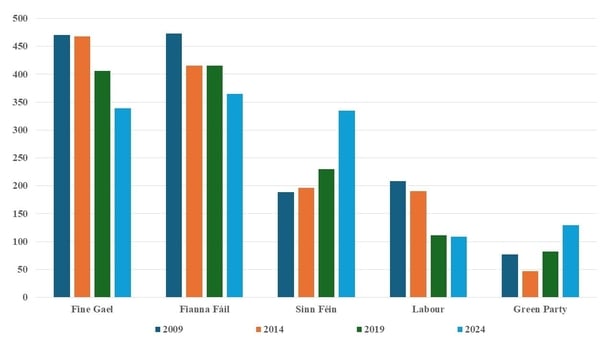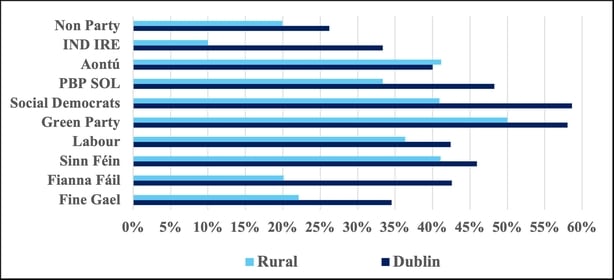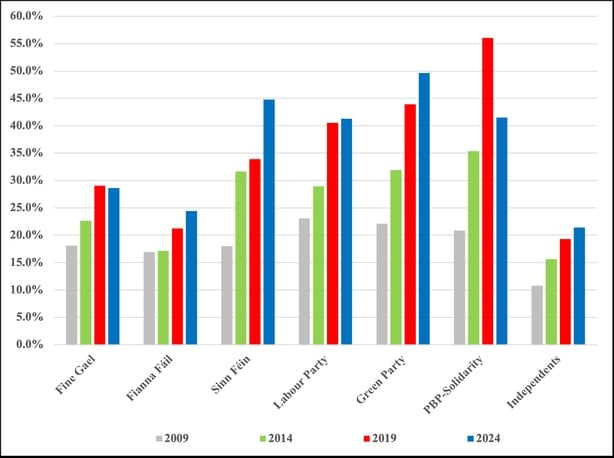Analysis: An estimated 2,169 candidates will be contesting the local elections this year, across 166 constituencies, with a 30/70 gender split
Local elections – County and City Council elections – will take place on June 7. While there has been a lot of focus on the size of the candidate lists for some of the European Parliament constituencies, most notably the 27 candidates running in the Midlands North West constituency, there is a much larger number of candidates running for the local elections, which is perhaps not surprising given that 166 constituencies (or electoral areas) are being contested this year.
I have been trailing local election candidate selections and declarations over the past year. Here, I outline the main trends that have emerged in relation to local election candidate selections. I don't have the historical data to conclusively claim that this year sees a record number of candidates running in the County and City Council election contests, although I suspect it could. However, the overall number of candidates is well up on the number that ran in the three previous election contests.
This year, I estimate that 2,169 candidates will be contesting these elections, which exceeds the numbers that ran for the 2019 (1,953), 2014 (1,981) and 2009 (1,840) County and City Council election contests. This comes despite an overall decrease in the number of Fianna Fáil, Fine Gael and Labour local election candidate numbers (Figure 1). These three parties, which dominated the old "two and a half party" system that shaped Irish politics up to the late 2000s, accounted for almost two-thirds (62.6%) of all candidates at the 2009 County and City Council elections, but this year these three parties only account for 37.5% of all local election candidates.

The big overall increase in candidate numbers has been fuelled, in part, by an overall increase in candidate numbers for Sinn Féin (and, to a lesser extent, the Green Party), but has been largely shaped by the large number of candidates running for a host of "smaller" parties, who have emerged over the last decade, including the Social Democrats, Aontú, and Independent Ireland, as well as an overall increase in the number of non-party candidates. 814 candidates are incumbents (sitting County or City Councillors), though 118 of these were not elected in 2019, but were instead co-opted to replace another councillor. By contrast, 132 sitting councillors have opted not to contest these elections for a variety of reasons.
Taking a geographical perspective on this, there are, notably, differences at the local authority level between the numbers of candidates who will be contesting these elections in Dublin City (172), Cork County (122) and South Dublin County (111), as compared with Leitrim (35), Cavan (36), Monaghan (36), Offaly (37) and Roscommon (37).
There are even more notable variations at the constituency/electoral area level. The constituency with the largest number of candidates this year is Cabra-Glasnevin, with 21 candidates, while 20 candidates will contest the constituencies of Portlaoise, Drogheda Urban, Kilkenny, Galway City East and Clondalkin. As they will have also the 27 candidate ballot paper for Midlands North West to contend with, voters in the Portlaoise and Drogheda Urban electoral areas will have the widest range of choice for this years elections. At the other extreme, there is only 5 candidates on the ballot paper for the (three-seat) Leixlip electoral area, while only 6 candidates will contest the Thurles and Kilmuckridge constituencies.
We need your consent to load this rte-player contentWe use rte-player to manage extra content that can set cookies on your device and collect data about your activity. Please review their details and accept them to load the content.Manage Preferences
From RTÉ Radio 1's Saturday with Colm Ó Mongáin, How many women are putting themselves forward in the local elections?
One of the big takeaways from this year’s candidate trends is the overall increase in the number of women for in the County and City Council elections. Back in 2009, only 317 women ran in the County and City Council elections (17.2% of all the candidates), but the number of female candidates has increased steadily over the past three local election contests, increasing to 440 (21.6% of all candidates) in 2014 and 561 (28.4% of all candidates) in 2019. I estimate that 681 women will contest this year’s elections, with these accounting for 31.4% of all candidates.
While the gender quota only applies for general (Dáil) election contests, there is no doubt that the introduction of the quota has impacted on local election candidacy levels. Most new TDs will previously have had experience of contesting local elections, so the quota encouraged political parties to run more female candidates at local elections to ensure that as many of their new female general election candidates had prior electoral experience, but also had an opportunity to create, and build on, a local support base. Furthermore, many of the structures and groups that were created to encourage female candidacies in the wake of the introduction of the quota also help to encourage more women to run in local elections.

As with everything in life, there is a definite geography here, with Dublin and the more urban areas tending to have the highest female candidacy levels for this year’s elections (and indeed previous electoral contests). Women account for 39.2% of all candidates in Dublin (and 45.0% of all candidates in Dún Laoghaire-Rathdown) but account for only 26.4% of all candidates in the Rural constituencies. As Figure 2 shows, urban-rural differences in female candidacy levels are also evident at the political party/grouping level, but even more so in the cases of Fianna Fáil and Fine Gael, as well as Independent Ireland (Figure 2).
At the constituency level, Cabra-Glasnevin has the highest number of female candidates (10), followed by Portlaoise and Kinnegad (9). Furthermore, six constituencies will have more female candidates than male candidates in these elections, including Stillorgan and Firhouse-Bohernabreena (women accounted for 63.6% of all candidates in both these constituencies), as well as Dún Laoghaire (57.1%), Kinnegad (56.3%), Naas (53.3%) and Cork City North East (53.3%). At the other extreme, two constituencies will have no female candidates in 2024, namely Moate and Corca Dhuibhne, although this is a much lower number than for the 2014 (27 constituencies) and 2019 (6) elections.

As Figure 3 shows, there as been a consistent increase in female candidate levels across different political parties and groupings between 2009 and 2024, although level did plateau somewhat, or even decline, for Fine Gael and People Before Profit this year. This also shows that the Green Party has the highest female candidacy level this year (almost a 50-50 gender breakdown) of the larger political parties/groupings, although Sinn Féin has the largest number of female candidates (150 candidates).
Looking at the smaller parties, two of these parties will be running more female candidates than male candidates – the Social Democrats and the Party for Animal Welfare, although the latter is only running five candidates – while women account for almost forty percent of Aontú local election candidates. At the other end of the scale, only eight of the 59 Independent Ireland candidates are women.
Follow RTÉ Brainstorm on WhatsApp and Instagram for more stories and updates
The views expressed here are those of the author and do not represent or reflect the views of RTÉ







